Analysis of the Impact of U.S. Trade Policy Uncertainty on China’s Grain Trade
Abstract
1. Introduction
2. Literature Review
2.1. Study on Factors Affecting Food Trade
2.2. Research on U.S. Trade Policy Uncertainty
3. Analytical Framework and Theoretical Assumptions
3.1. Direct Channel Impact
3.1.1. International Supply Channels
3.1.2. Domestic Demand Channels
3.2. Indirect Impact Channels
3.2.1. Domestic Supply Channel
3.2.2. Financial and Monetary Channels
4. Materials and Methods
4.1. Methodology
4.2. Model Construction
4.3. Data Sources and Description
4.3.1. Data Description
4.3.2. Data Preprocessing
5. Empirical Results and Analyses
5.1. Smoothness Test of the Series and Determination of the Lag Order of the Variables
5.2. Model Estimation and Diagnostic Results
5.3. Analysis of Empirical Results
5.3.1. Time-Varying Impulse Response Results
- (1)
- Time-varying impulse response of grain imports.
- (2)
- Time-varying impulse response of grain export volume.
5.3.2. Time-Varying Impulse Response Characteristics
- (1)
- Characteristics of Impulse Response in Different Periods.
- (2)
- Impulse response characteristics of different products.
5.3.3. Time-Point Impulse Response Analysis
6. Discussion
6.1. The Impact of U.S. Trade Policy Uncertainty on China’s Grain Trade Varies across Time
6.2. Heterogeneity in the Impact of U.S. Trade Policy Uncertainty on China’s Grain Trade
6.3. The Impact of U.S. Trade Policy Uncertainty on China’s Grain Trade Has a Significant Point-in-Time Effect
7. Conclusions
Author Contributions
Funding
Institutional Review Board Statement
Informed Consent Statement
Data Availability Statement
Conflicts of Interest
References
- Iashina, E.A.; Evgrafova, L.V.; Dzhancharova, G.K.; Ukolova, A.V.; Kovaleva, E.V. Analysis of the dynamics of food security in the countries of the Eurasian Economic Union. Front. Sustain. Food Syst. 2023, 7, 1114469. [Google Scholar] [CrossRef]
- Zhang, Y.T.; Zhou, W.X. Quantifying the status of economies in international crop trade networks: A correlation structure analysis of various node-ranking metrics. Chaos Solitons Fractals 2023, 172, 113567. [Google Scholar] [CrossRef]
- General Administration of Customs of the People’s Republic of China. Available online: http://www.customs.gov.cn/customs/302249/zfxxgk/2799825/302274/302277/3512606/index.html (accessed on 27 April 2024).
- Boyer, J.S.; Byrne, P.; Cassman, K.G.; Cooper, M.; Delmer, D.; Greene, T.; Gruis, F.; Habben, J.; Hausmann, N.; Kenny, N.; et al. The US drought of 2012 in perspective: A call to action. Glob. Food Secur.-Agric. Policy Econ. Environ. 2013, 2, 139–143. [Google Scholar] [CrossRef]
- Li, H.Z. Impact of Natural Disasters on China’s Soybean Imports. Master’s Thesis, Cornell University, Ithaca, NY, USA, 2023. [Google Scholar]
- USDA Foreign Agricultural Service. Available online: https://fas.usda.gov/data/trade (accessed on 28 April 2024).
- Gao, X.; Insuwan, A.; Li, Z.; Tian, S. The dynamics of price discovery between the U.S. and Chinese soybean market: A wavelet approach to understanding the effects of Sino-US trade conflict and COVID-19 pandemic. Data Sci. Manag. 2024, 7, 35–46. [Google Scholar] [CrossRef]
- Wen, T.; Li, P.; Chen, L.; An, Y. Market reactions to trade friction between China and the United States: Evidence from the soybean futures market. J. Manag. Sci. Eng. 2023, 8, 325–341. [Google Scholar] [CrossRef]
- Willer, D.F.; Aldridge, D.C. Enhancing domestic consumption to deliver food security in a volatile world. Glob. Sustain. 2023, 6, e18. [Google Scholar] [CrossRef]
- Zhou, Y.; Ji, Y. Trade Policy Uncertainty, Innovation and Total Factor Productivity. Sustainability 2022, 14, 266. [Google Scholar] [CrossRef]
- Mei, D.X.; Xie, Y.T. US grain commodity futures price volatility: Does trade policy uncertainty matter? Financ. Res. Lett. 2022, 48, 103028. [Google Scholar] [CrossRef]
- Pöyhönen, P. A Tentative Model for the Volume of Trade between Countries. Weltwirtschaftliches Arch. 1963, 90, 93–100. [Google Scholar]
- Handley, K.; Limao, N. Trade and Investment under Policy Uncertainty: Theory and Firm Evidence. Am. Econ. J.-Econ. Policy 2015, 7, 189–222. [Google Scholar] [CrossRef]
- Handley, K.; Limao, N. Policy Uncertainty, Trade, and Welfare: Theory and Evidence for China and the United States. Am. Econ. Rev. 2017, 9, 2731–2783. [Google Scholar] [CrossRef]
- EunJung, L.; Jun, S.-H. Impact of Distance and Trade Costs on the Bilateral Trade between Developing Countries. Int. Commer. Inf. Rev. 2020, 22, 395–417. [Google Scholar]
- Liu, A.; Lu, C.; Wang, Z. The roles of cultural and institutional distance in international trade: Evidence from China’s trade with the Belt and Road countries. China Econ. Rev. 2020, 61, 101234. [Google Scholar] [CrossRef]
- Wang, C.Y.; Wang, Y.W.; Zhong, S. Empirical Analysis on RMB Exchange Rate Volatility and Import and Export Commodities Trading in China. In Proceedings of the Eighth Wuhan International Conference on E-Business, Wuhan, China, 24–26 May 2009; Volume i–iii, pp. 1489–1494. Available online: https://webofscience.clarivate.cn/wos/alldb/full-record/WOS:000267479300235 (accessed on 17 January 2024).
- Wu, C.Z. Research on Impact of Exchange Rate to China’s Agricultural Products Export Based on Trade Gravity Model. 2010. Available online: https://www.sciencedirect.com/science/article/pii/S2666660X21000323 (accessed on 17 January 2024).
- Zhou, J.H.; Wang, Y.; Mao, R.; Zheng, Y.Q. Examining the role of border protectionism in border inspections: Panel structural vector autoregression evidence from FDA import refusals on China’s agricultural exports. China Agric. Econ. Rev. 2021, 13, 593–613. [Google Scholar] [CrossRef]
- Zhou, L.Z.; Tong, G.J.; Qi, J.G.; He, L. China and Countries along the “Belt and Road”: Agricultural Trade Volatility Decomposition and Food Security. Agriculture 2022, 12, 1850. [Google Scholar] [CrossRef]
- Singh, K.; Dey, M.M. International competitiveness of catfish in the U.S. market: A constant market share analysis. Aquac. Econ. Manag. 2011, 15, 214–229. [Google Scholar] [CrossRef]
- Miao, M.; Liu, H.; Chen, J. Factors affecting fluctuations in China’s aquatic product exports to Japan, the USA, South Korea, Southeast Asia, and the EU. Aquac. Int. 2021, 29, 2507–2533. [Google Scholar] [CrossRef]
- Fu, H.L.; Huang, C.L.; Teng, Z.Q.; Fang, Y.T. Market Structure, International Competitiveness, and Price Formation of Hainan’s Fruit Exports. Discret. Dyn. Nat. Soc. 2021, 2021, 6664780. [Google Scholar] [CrossRef]
- Li, D.K.; Zhang, F.; Li, X.Z. Can US trade policy uncertainty help in predicting stock market excess return? Financ. Res. Lett. 2022, 49, 103136. [Google Scholar] [CrossRef]
- Zhang, R.X.; Qu, Y.H. The Impact of US Trade Policy Uncertainty on the Trade Margins of China’s Export to the US. Sustainability 2022, 14, 15101. [Google Scholar] [CrossRef]
- Bahmani-Oskooee, M.; Xu, J. Whose policy uncertainty matters in the trade between China and the US? Econ. Chang. Restruct. 2022, 55, 1497–1542. [Google Scholar] [CrossRef]
- Saxegaard, E.C.A.; Davis, S.; Ito, A.; Miake, N. Policy uncertainty in Japan. J. Jpn. Int. Econ. 2022, 64, 101192. [Google Scholar] [CrossRef]
- Yan, H.; Xiao, W.G.; Deng, Q.; Xiong, S.S. Analysis of the Impact of US Trade Policy Uncertainty on China Based on Bayesian VAR Model. J. Math. 2022, 2022, 7124997. [Google Scholar] [CrossRef]
- Burke, J.P. The Contemporary Presidency “It Went Off the Rails”: Trump’s Presidential Transition and the National Security System. Pres. Stud. Q. 2018, 48, 832–844. [Google Scholar] [CrossRef]
- Riley, J. The Legal and Policy Implications of the US Steel Tariffs on East Asia. J. East Asia Int. Law 2018, 11, 193–204. [Google Scholar] [CrossRef]
- Kim, S.E.; Pelc, K.J. The Politics of Trade Adjustment Versus Trade Protection. Comp. Political Stud. 2021, 54, 2354–2381. [Google Scholar] [CrossRef]
- Tyers, R.O.D.; Zhou, Y.X. The US-China trade dispute: A macroperspective. Singap. Econ. Rev. 2021, 1–28. [Google Scholar] [CrossRef]
- Dadush, U. American Protectionism. Rev. D Econ. Polit. 2023, 133, 497–524. [Google Scholar] [CrossRef]
- Chung, M. Legislative and Policy Trends and Implications Related to the Protection of Trade Secrets of the Biden Administration in the US. Korean J. Int. Econ. Law 2021, 19, 77–112. [Google Scholar] [CrossRef]
- Li, C.D.; Whalley, J. Trade protectionism and US manufacturing employment. Econ. Model. 2021, 96, 353–361. [Google Scholar] [CrossRef]
- Bown, C.P. How the United States Marched the Semiconductor Industry into Its Trade War with China. East Asian Econ. Rev. 2020, 24, 349–388. [Google Scholar] [CrossRef]
- Chen, Y.F.; Zhang, S.; Miao, J.F. The negative effects of the US-China trade war on innovation: Evidence from the Chinese ICT industry. Technovation 2023, 123, 102734. [Google Scholar] [CrossRef]
- Chengying, H.; Rui, C.; Ying, L. US-China trade war and China’s stock market: An event-driven analysis. Econ. Res.-Ekon. Istraž. 2022, 35, 3277–3290. [Google Scholar] [CrossRef]
- Sha, F.Y.; Zhao, Y. The impact of the China-US trade war on firms’ financial performance-Evidence from China. Appl. Econ. 2023, 1–4. [Google Scholar] [CrossRef]
- Zhao, J.C.; Huang, Q.A.; Wu, X.Q.; Xiao, L. The impact of trade war on Shanghai stock exchange industry based on Granger causality network. Acta Phys. Sin. 2021, 70, 1–9. [Google Scholar] [CrossRef]
- Long, S.B.; Li, J.Y.; Luo, T.Y. The asymmetric impact of global economic policy uncertainty on international grain prices. J. Commod. Mark. 2023, 30, 100273. [Google Scholar] [CrossRef]
- Wang, X.; Yang, Y.; Tang, M.; Wang, X. The effect of macroeconomic regimes, uncertainty, and COVID-19 outcomes on commodity price volatility: Implications for green economic recovery. Econ. Res.-Ekon. Istraž. 2023, 36, 2164036. [Google Scholar] [CrossRef]
- Chen, B.W.; Villoria, N.B.; Xia, T. Tariff quota administration in China’s grain markets: An empirical assessment. Agric. Econ. 2020, 51, 191–206. [Google Scholar] [CrossRef]
- Paz, L.S.; dos Reis, M.; de Azevedo, A.F.Z. New Evidence on WTO Membership After the Uruguay Round: An Analysis at the Sectoral Level. Open Econ. Rev. 2024, 35, 1–39. [Google Scholar] [CrossRef]
- Lopes, J.S. Dispute Settlement System of the WTO: A Powerful Weapon for Developing Countries. In The WTO Dispute Settlement Mechanism: A Developing Country Perspective; do Amaral Júnior, A., de Oliveira Sá Pires, L.M., Lucena Carneiro, C., Eds.; Springer International Publishing: Cham, Switzerland, 2019; pp. 43–53. [Google Scholar]
- Moon, D. The Changing Status of Developing Countries under the World Trade Organization Dispute Settlement Mechanism. Pac. Focus 2010, 25, 136–160. [Google Scholar] [CrossRef]
- Moosa, I.; Burns, K. Do the Chinese Exchange Rate and Trade Policies Violate International Rules? Transnatl. Corp. Rev. 2012, 4, 50–60. [Google Scholar] [CrossRef]
- Rena, R. Impact of WTO Policies on Developing Countries: Issues and Perspectives. Transnatl. Corp. Rev. 2012, 4, 77–88. [Google Scholar] [CrossRef]
- Lang, Y.; Li, C. The impact of WTO reform on china’s economy: Some numerical simulation results. Transnatl. Corp. Rev. 2021, 13, 422–436. [Google Scholar] [CrossRef]
- China Will Propose WTO Reforms, but Don’t Try to Trap Us, Says Beijing’s WTO Envoy. Available online: https://www.cnbctv18.com/economy/china-will-propose-wto-reforms-but-dont-try-to-trap-us-says-beijings-wto-envoy-1443401.htm (accessed on 28 April 2024).
- Beckman, J.; Ivanic, M.; Shaik, S. How bilateral trade deals get in the way of multilateral agreements: Why WTO is marginalized. J. Policy Model. 2023, 45, 877–894. [Google Scholar] [CrossRef]
- Katona, G. Psychological Analysis of Economic Behavior; McGraw-Hill: New York, NY, USA, 1951; p. 347. [Google Scholar]
- Drezner, D.W. Economic Interdependence and War. J. Cold War Stud. 2015, 17, 228–231. [Google Scholar] [CrossRef]
- Tan, Y.; Zhao, C.C. Firms’ heterogeneity, demand accumulating, and exchange rate pass-through. South. Econ. J. 2020, 87, 700–731. [Google Scholar] [CrossRef]
- Sasaki, N.Z. Effects of Agricultural Policies in Kenya: An Analytical Framework and Application in the Maize Market. Ph.D. Thesis, The University of Arizona, Tucson, AZ, USA, 2000. [Google Scholar]
- Carreras Valle, M.J.Z. Essays on Trade Under Uncertainty. Ph.D. Thesis, University of Minnesota, Minneapolis, MN, USA, 2022. [Google Scholar]
- Li, J.; Rugman, A.M. Real options and the theory of foreign direct investment. Int. Bus. Rev. 2007, 16, 687–712. [Google Scholar] [CrossRef]
- He, Y.; Hu, W.; Li, K.; Zhang, X. Can real options explain the impact of uncertainty on Chinese corporate investment? Econ. Model. 2022, 115, 105927. [Google Scholar] [CrossRef]
- Duku-Kaakyire, A.; Nanang, D.M. Application of real options theory to forestry investment analysis. For. Policy Econ. 2004, 6, 539–552. [Google Scholar] [CrossRef]
- Kim, M.; Kim, J.-H.; Park, M.; Yoo, J. The roles of sensory perceptions and mental imagery in consumer decision-making. J. Retail. Consum. Serv. 2021, 61, 102517. [Google Scholar] [CrossRef]
- Zhang, G.; Li, G.; Shang, J. Optimizing mixed bundle pricing strategy: Advance selling and consumer regret. Omega 2023, 115, 102782. [Google Scholar] [CrossRef]
- Hong, M.Y.; Wang, J.; Tian, M.J. Rural Social Security, Precautionary Savings, and the Upgrading of Rural Residents’ Consumption Structure in China. Sustainability 2022, 14, 12455. [Google Scholar] [CrossRef]
- Jory, S.R.; Khieu, H.D.; Ngo, T.N.; Phan, H.V. The influence of economic policy uncertainty on corporate trade credit and firm value. J. Corp. Financ. 2020, 64, 101671. [Google Scholar] [CrossRef]
- Ngo, T.Q.Z. Export -Led Growth and Crowding -Out Effect Case Study: A Cointegration Approach. Ph.D. Thesis, Colorado State University, Fort Collins, CO, USA, 2009. [Google Scholar]
- Yang, C.H.; Hayakawa, K. The Substitution Effect of US-China Trade War on Taiwanese Trade. Dev. Econ. 2023, 61, 324–341. [Google Scholar] [CrossRef]
- Lei, C.C.; Qi, Q.W.; Fu, Y.; Jiang, L.L.; Liang, Q.Z. Analysis on Mechanism of China’s Grain Production Development and Evolution From 1985 to 2019. IEEE Access 2022, 10, 43221–43234. [Google Scholar] [CrossRef]
- Qiao, F.B. The Impact of Agricultural Service on Grain Production in China. Sustainability 2020, 12, 6249. [Google Scholar] [CrossRef]
- Zhang, J.H. China’s success in increasing per capita food production. J. Exp. Bot. 2011, 62, 3707–3711. [Google Scholar] [CrossRef] [PubMed]
- Chen, T.; Luo, W.J.; Xiang, X.Y. Exchange rate pass-through to export prices in China: Does product quality matter? Appl. Econ. 2023, 11, 1–15. [Google Scholar] [CrossRef]
- Akdogan, K.; Bagir, Y.K.; Torun, H. Heterogeneous effect of exchange rates on firms’ exports: Role of labor intensity. Cent. Bank Rev. 2023, 23, 100130. [Google Scholar] [CrossRef]
- Prado, R.; Huerta, G. Time-varying autoregressions with model order uncertainty. J. Time Ser. Anal. 2002, 23, 599–618. [Google Scholar] [CrossRef]
- Balcilar, M.; Gupta, R.; van Eyden, R.; Thompson, K.; Majumdar, A. Comparing the forecasting ability of financial conditions indices: The case of South Africa. Q. Rev. Econ. Financ. 2018, 69, 245–259. [Google Scholar] [CrossRef]
- Kim, S. Effects of Monetary Policy during Financial Market Crises and Regime Changes: An Empirical Evaluation Using a Nonlinear Vector Autoregression Model. Asian Econ. J. 2018, 32, 105–123. [Google Scholar] [CrossRef]
- Sims, C.A.J.E. Macroeconomics and reality. Econom. J. Econom. Soc. 1980, 48, 1–48. [Google Scholar] [CrossRef]
- Primiceri, G.E. Time Varying Structural Vector Autoregressions and Monetary Policy. Rev. Econ. Stud. 2005, 72, 821–852. [Google Scholar] [CrossRef]
- Nakajima, J.J.M.; Studies, A.E. Time-Varying Parameter VAR Model with Stochastic Volatility: An Overview of Methodology and Empirical Applications. Monet. Econ. Stud. 2011, 29, 107–142. [Google Scholar]
- Baker, S.R.; Bloom, N.; Davis, S.J. Measuring Economic Policy Uncertainty*. Q. J. Econ. 2016, 131, 1593–1636. [Google Scholar] [CrossRef]
- Villoria, N. The effects of China’s growth on the food prices and the food exports of other developing countries. Agric. Econ. 2012, 43, 499–514. [Google Scholar] [CrossRef]
- Yotov, Y.V. Trade adjustment, political pressure, and trade protection patterns. Econ. Inq. 2013, 51, 1867–1885. [Google Scholar] [CrossRef]
- Adjemian, M.K.; Smith, A.; He, W.D. Estimating the market effect of a trade war: The case of soybean tariffs. Food Policy 2021, 105, 102152. [Google Scholar] [CrossRef]
- Chen, Z.; Yan, B. The impact of trade policy on soybean futures in China. Manag. Decis. Econ. 2022, 43, 1152–1163. [Google Scholar] [CrossRef]
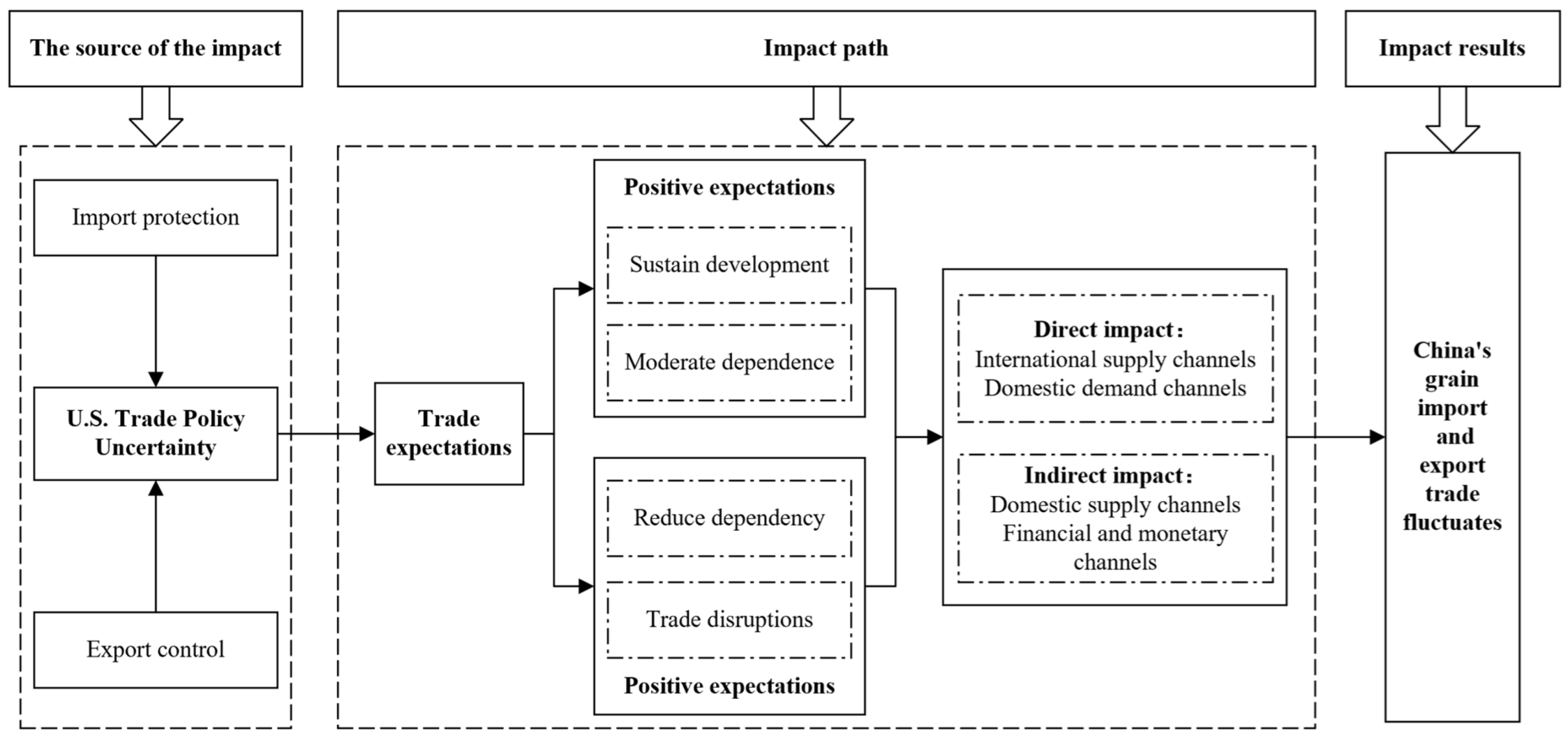

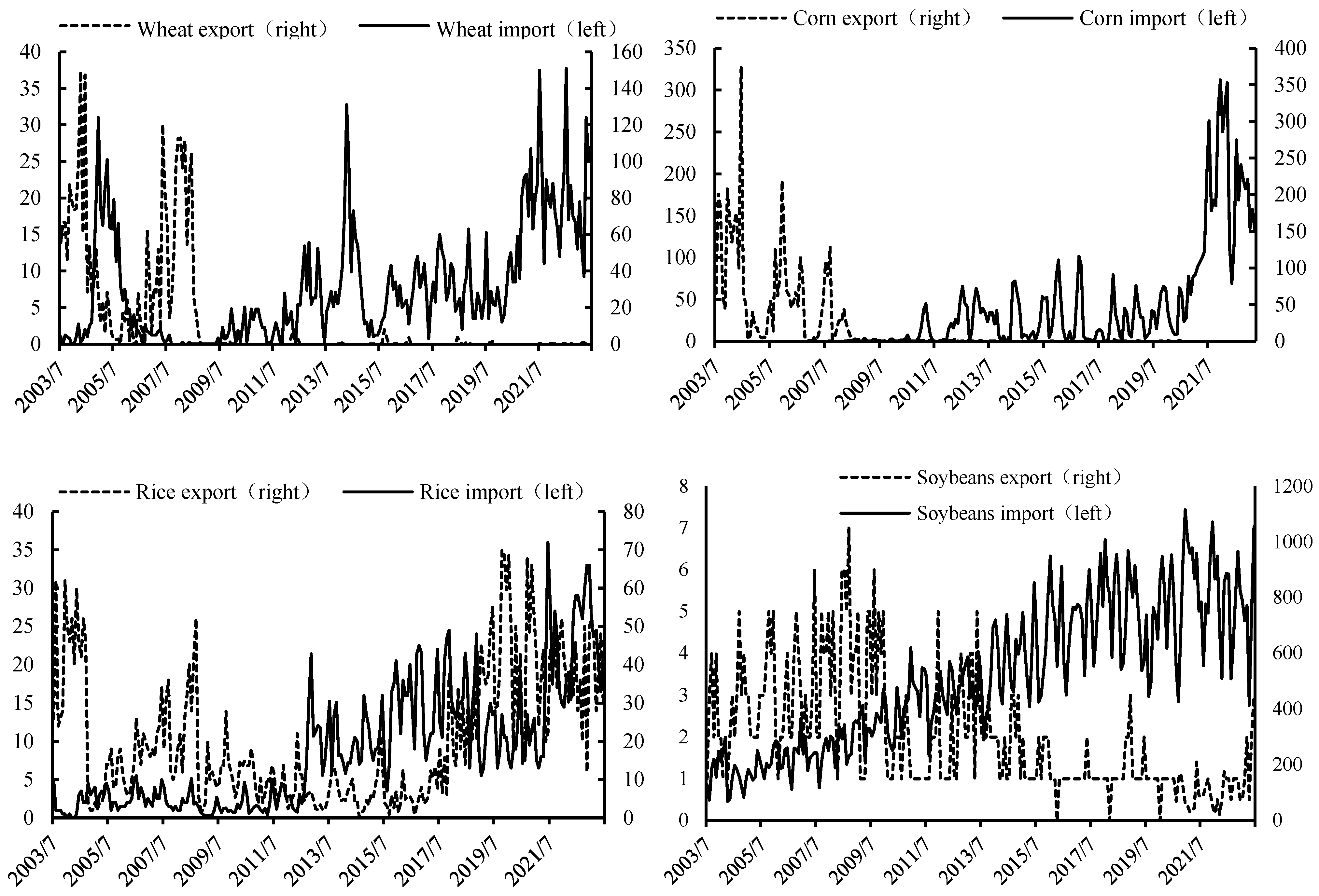

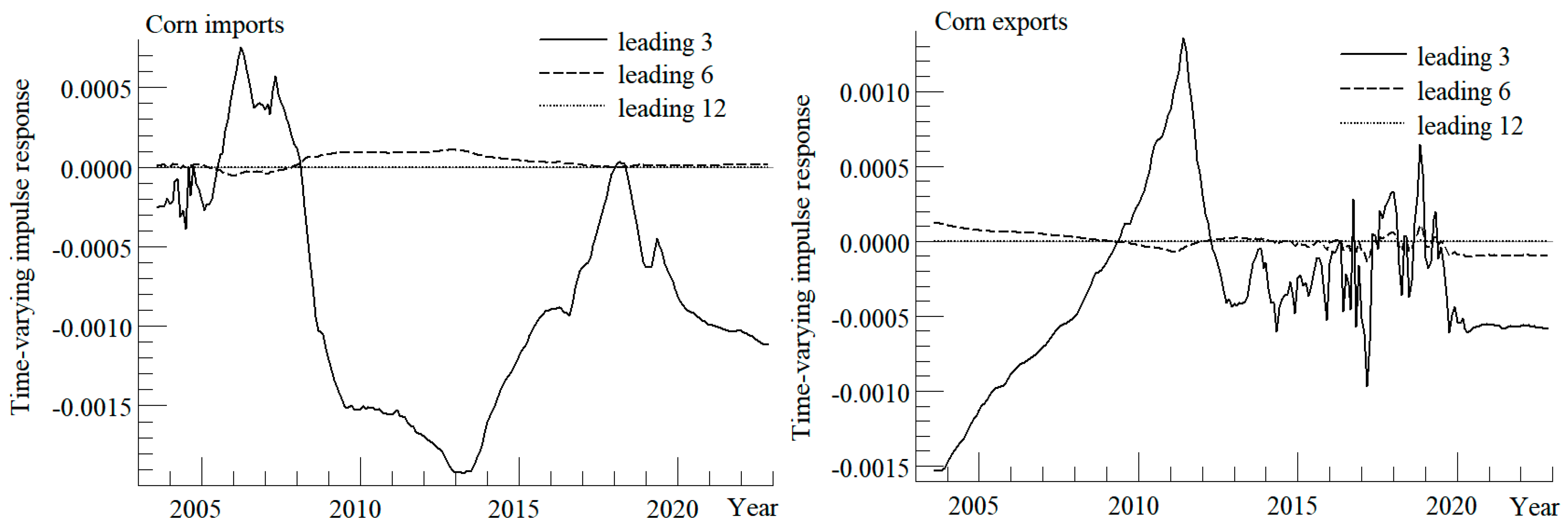

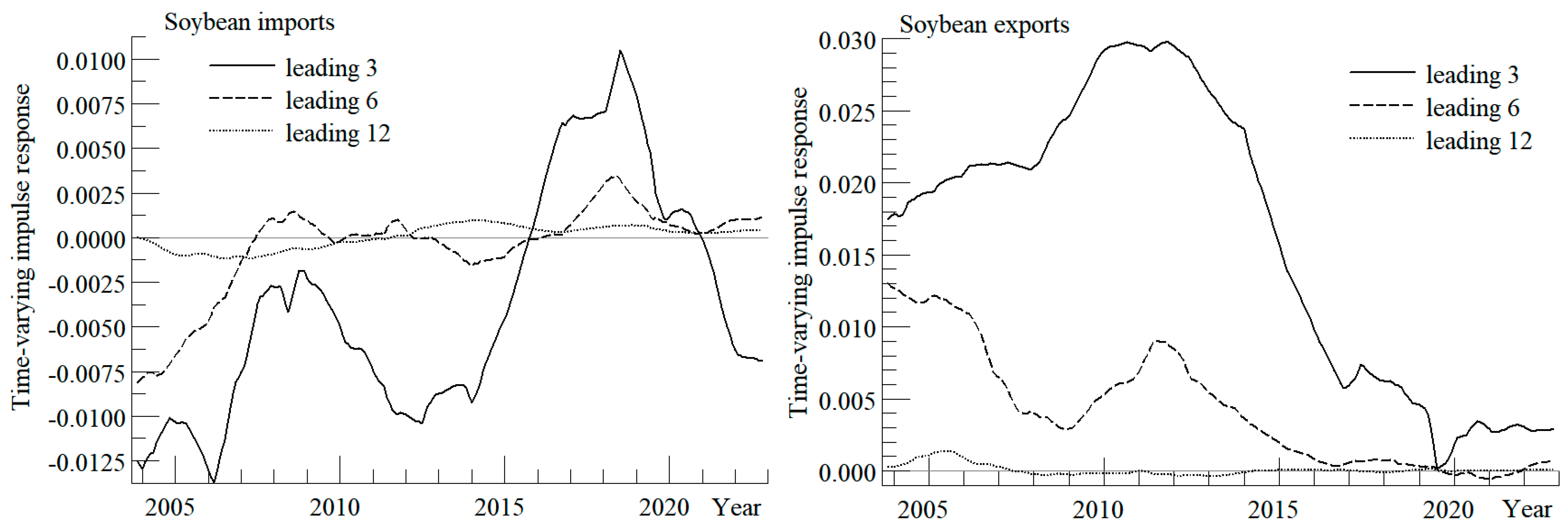
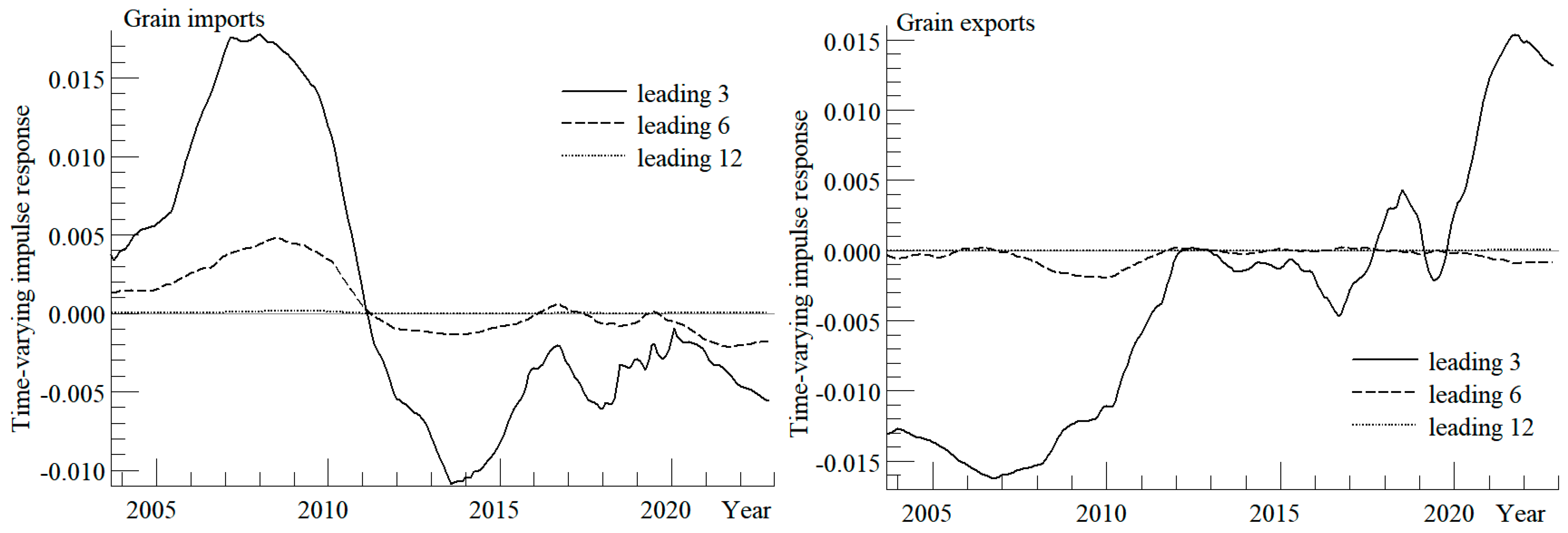


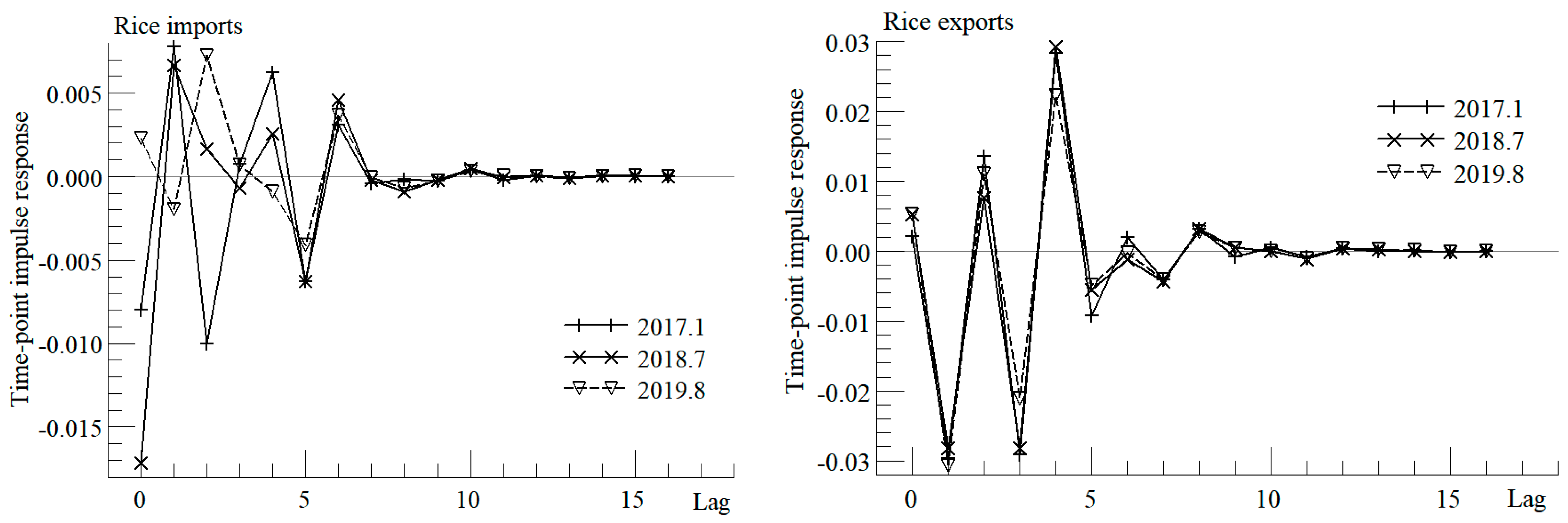
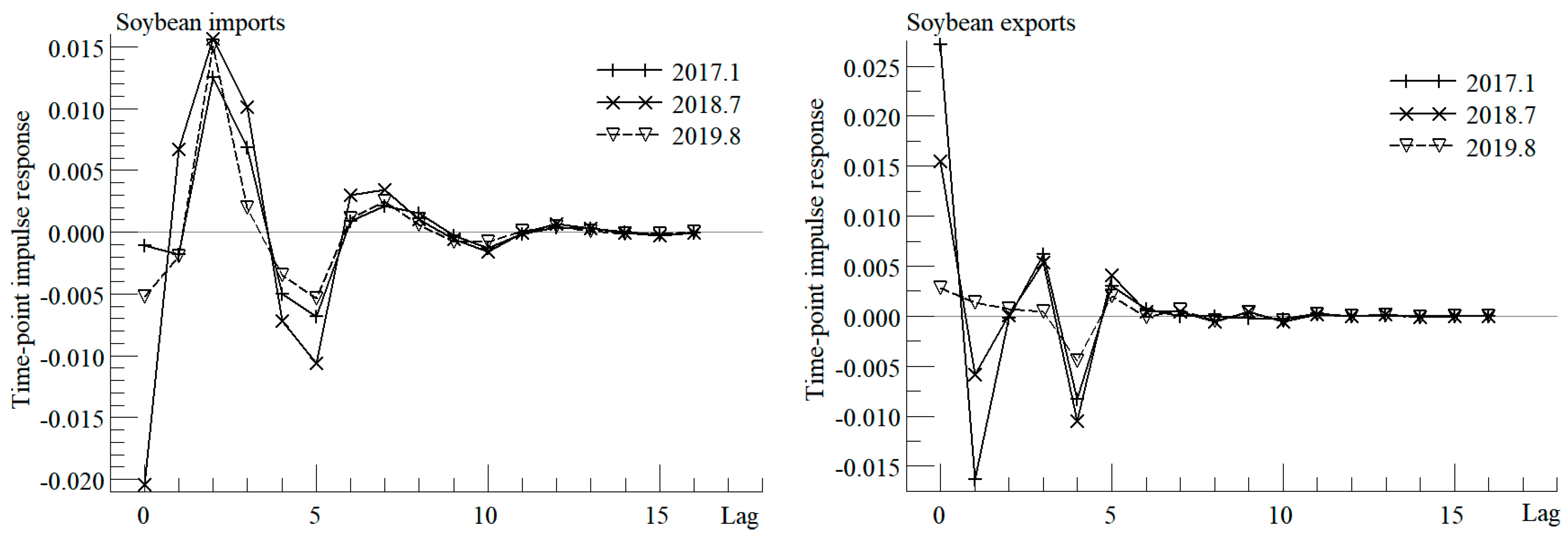
| Type | Variable | Mean | S.D. | Skewness | Kurtosis | Observations |
|---|---|---|---|---|---|---|
| Wheat | Import volume | 0.0140 | 0.5772 | 0.5311 | 9.5525 | 233 |
| Export volume | −0.0118 | 0.6421 | −0.1393 | 21.3842 | 233 | |
| Corn | Import volume | 0.0048 | 0.4106 | −0.4942 | 16.5329 | 233 |
| Export volume | −0.0016 | 0.7960 | −1.6738 | 58.2468 | 233 | |
| Rice | Import volume | 0.0076 | 0.3749 | −0.0993 | 5.8748 | 233 |
| Export volume | 0.0059 | 0.6646 | −0.2235 | 7.1398 | 233 | |
| Soybeans | Import volume | 0.0132 | 0.3720 | −0.5361 | 5.3509 | 233 |
| Export volume | 0.0092 | 0.7540 | −0.4047 | 9.1238 | 233 | |
| UTPT | −0.0007 | 0.6863 | 1.6835 | 36.5491 | 233 | |
| Type | Variable | Test Type (C, T, K) | ADF Statistic | Critical Value (1%) | Conclusion |
|---|---|---|---|---|---|
| Wheat | Import volume | (C, T, 1) | −15.0825 *** | −3.9982 | Smooth |
| Export volume | (C, T, 1) | −13.9111 *** | −3.9982 | Smooth | |
| Corn | Import volume | (C, T, 1) | −12.4770 *** | −3.9982 | Smooth |
| Export volume | (C, T, 1) | −13.6320 *** | −3.9982 | Smooth | |
| Rice | Import volume | (C, T, 1) | −14.5536 *** | −3.9982 | Smooth |
| Export volume | (C, T, 1) | −15.8825 *** | −3.9982 | Smooth | |
| Soybeans | Import volume | (C, T, 1) | −16.7825 *** | −3.9982 | Smooth |
| Export volume | (C, T, 1) | −16.3362 *** | −3.9982 | Smooth | |
| UTPT | (C, T, 1) | −15.4513 *** | −3.9982 | Smooth | |
| Type | Order | LR | FPE | AIC | SC | HQ |
|---|---|---|---|---|---|---|
| Wheat | 1 | 160.3424 | 0.0313 | 5.0496 | 5.2295 * | 5.1222 * |
| 2 | 17.8152 * | 0.0312 * | 5.0479 * | 5.3628 | 5.1750 | |
| 3 | 5.2736 | 0.0330 | 5.1025 | 5.5523 | 5.2839 | |
| 4 | 1.4008 | 0.0354 | 5.1746 | 5.7594 | 5.4105 | |
| Corn | 1 | 138.9535 | 0.0303 | 5.1983 * | 5.1983 * | 5.0910 * |
| 2 | 10.0280 | 0.0313 * | 5.0518 | 5.3667 | 5.1788 | |
| 3 | 20.7554 * | 0.0308 | 5.0356 | 5.4855 | 5.2171 | |
| 4 | 6.7761 | 0.0323 | 5.0829 | 5.6676 | 5.3188 | |
| Rice | 1 | 140.6161 | 0.0177 | 4.4808 | 4.6608 * | 4.5534 |
| 2 | 33.8464 | 0.0164 | 4.4070 | 4.7219 | 4.5340 * | |
| 3 | 22.2274 * | 0.0160 * | 4.3841 * | 4.8339 | 4.5656 | |
| 4 | 6.9275 | 0.0168 | 4.4306 | 5.0154 | 4.6665 | |
| Soybean | 1 | 140.7085 | 0.0216 | 4.6795 | 4.8595 * | 4.7521 |
| 2 | 42.6280 | 0.0193 | 4.5661 | 4.8810 | 4.6932 | |
| 3 | 40.4363 | 0.0173 | 4.4601 | 4.9099 | 4.6416 * | |
| 4 | 24.3721 * | 0.0167 * | 4.4259 * | 5.0106 | 4.6618 |
| Type | Parametric | ||||||
|---|---|---|---|---|---|---|---|
| Wheat | Geweke | 0.10 | 0.81 | 0.00 | 0.12 | 0.52 | 0.99 |
| Negative factor | 11.49 | 11.96 | 63.69 | 28.99 | 41.75 | 41.70 | |
| Corn | Geweke | 0.51 | 0.01 | 0.53 | 0.13 | 0.00 | 0.00 |
| Negative factor | 12.87 | 11.37 | 22.67 | 24.09 | 36.46 | 126.10 | |
| Rice | Geweke | 0.06 | 0.77 | 0.49 | 0.34 | 0.82 | 0.96 |
| Negative factor | 12.38 | 12.67 | 51.00 | 62.58 | 39.24 | 65.51 | |
| Soybeans | Geweke | 0.75 | 0.04 | 0.31 | 0.09 | 0.10 | 0.26 |
| Negative factor | 13.12 | 13.35 | 61.85 | 75.55 | 63.69 | 102.34 |
Disclaimer/Publisher’s Note: The statements, opinions and data contained in all publications are solely those of the individual author(s) and contributor(s) and not of MDPI and/or the editor(s). MDPI and/or the editor(s) disclaim responsibility for any injury to people or property resulting from any ideas, methods, instructions or products referred to in the content. |
© 2024 by the authors. Licensee MDPI, Basel, Switzerland. This article is an open access article distributed under the terms and conditions of the Creative Commons Attribution (CC BY) license (https://creativecommons.org/licenses/by/4.0/).
Share and Cite
Yang, L.; Gai, Y.; Zhang, A.; Wang, L. Analysis of the Impact of U.S. Trade Policy Uncertainty on China’s Grain Trade. Sustainability 2024, 16, 4332. https://doi.org/10.3390/su16114332
Yang L, Gai Y, Zhang A, Wang L. Analysis of the Impact of U.S. Trade Policy Uncertainty on China’s Grain Trade. Sustainability. 2024; 16(11):4332. https://doi.org/10.3390/su16114332
Chicago/Turabian StyleYang, Lulu, Yankai Gai, An Zhang, and Lihui Wang. 2024. "Analysis of the Impact of U.S. Trade Policy Uncertainty on China’s Grain Trade" Sustainability 16, no. 11: 4332. https://doi.org/10.3390/su16114332
APA StyleYang, L., Gai, Y., Zhang, A., & Wang, L. (2024). Analysis of the Impact of U.S. Trade Policy Uncertainty on China’s Grain Trade. Sustainability, 16(11), 4332. https://doi.org/10.3390/su16114332








